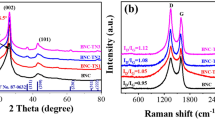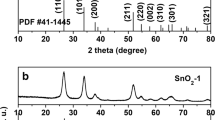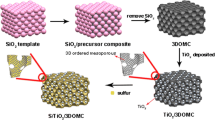Abstract
Li–S battery is an attractive electrochemical energy storage system because of its high energy density. However, its commercialization has been greatly affected by the poor cycle life and low rate performance, which is attributed to the dissolution of polysulfides and their shuttle effects. In this study, titanium dioxide particles with a large amount of exposed {001} facets (TDPEF) were prepared by alcohol-thermal method. The as-prepared TDPEF achieved a relatively high specific surface area of 92 m2 g−1 and a pore volume of 0.27 cm g−1. Sulfur was mixed with the TDPEF to form TDPEF/S composite by a melt diffusion process. The TDPEF/S composite exhibits much excellent discharge capacity retention of 80 % after 100 cycles compared with pure sulfur at a high current rate of 0.5 C, and it still has a discharge capacity as high as 530 mAh g−1 even at the current rate of 4 C.






Similar content being viewed by others
References
Manthiram A, Fu Y, Chung SH, Zu C, Su YS (2014) Rechargeable lithium–sulfur batteries. Chem Rev 114:11751–11787
Yin YX, Xin S, Guo YG, Wan LJ (2013) Lithium–sulfur batteries: electrochemistry, materials, and prospects. Angew Chem Int Edit 52:13186–13200
Chen R, Zhao T, Wu F (2015) From a historic review to horizons beyond: lithium–sulphur batteries run on the wheels. Chem Commun 51(1):18–33
Lin Z, Liu Z, Fu W, Dudney NJ, Liang C (2013) Phosphorous Pentasulfide as a novel additive for high-performance lithium-sulfur batteries. Adv Funct Mater 23(8):1064–1069
Ding B, Shen L, Xu G, Nie P, Zhang X (2013) Encapsulating sulfur into mesoporous TiO2 host as a high performance cathode for lithium–sulfur battery. Electrochim Acta 107:78–84
Yuan LX, Feng J, Ai XP, Cao YL, Chen SL, Yang HX (2006) Improved dischargeability and reversibility of sulfur cathode in a novel ionic liquid electrolyte. Electrochem Commun 8(4):610–614
Ma XZ, Jin B, Wang HY, HouJZ ZXB, Wang HH, Xin PM (2015) S–TiO2 composite cathode materials for lithium/sulfur batteries. J Electroanal Chem 736:127–131
Qu Y, Zhang Z, Zhang X, Ren G, Lai Y, Liu Y, Li J (2015) Highly ordered nitrogen-rich mesoporous carbon derived from biomass waste for high-performance lithium–sulfur batteries. Carbon 84:399–408
Tang H, Yao S, Jing M, Wu X, Hou J, Qian X, Xiao K (2015) Nickel fibers/sulfur composites cathode with enhanced electrochemical performance for rechargeable lithium-sulfur batteries. Electrochim Acta 176:442–447
Tang H, Yao S, Jing M, Wu X, Hou J, Qian X, Xiao K (2015) Mg0.6Ni0.4 O hollow nanofibers prepared by electrospinning as additive for improving electrochemical performance of lithium–sulfur batteries. J Alloy Compd 650:351–356
Wu HB, Wei S, Zhang L, Xu R, Hng HH, Lou XW (2013) Embedding sulfur in MOF-derived microporous carbon polyhedrons for lithium-sulfur batteries. Chem-Eur J 19(33):10804–10808
Zheng J, Tian J, Wu D, Gu M, Xu W, Wang C, Gao F, Engelhard MH, Zhang JG, Liu J, Xiao J (2014) Lewis acid–base interactions between polysulfides and metal organic framework in lithium sulfur batteries. Nano Lett 14(5):2345–2352
Bao W, Zhang Z, Zhou C, Lai Y, Li J (2014) Multi-walled carbon nanotubes@ mesoporous carbon hybrid nanocomposites from carbonized multi-walled carbon nanotubes@ metal–organic framework for lithium sulfur battery. J Power Sources 248:570–576
Li X, Sun Q, Liu J, Xiao B, Li R, Sun X (2016) Tunable porous structure of metal organic framework derived carbon and the application in lithium–sulfur batteries. J Power Sources 302:174–179
Wang Z, Wang B, Yang Y, Cui Y, Wang Z, Chen B, Qian G (2015) Mixed-metal–organic framework with effective lewis acidic sites for sulfur confinement in high-performance lithium–sulfur batteries. ACS Appl Mater Inter 7(37):20999–21004
Ji L, Rao M, Zheng H, Zhang L, Li Y, Duan W, Zhang Y (2011) Graphene oxide as a sulfur immobilizer in high performance lithium/sulfur cells. J Am Chem Soc 133(46):18522–18525
Guo J, Xu Y, Wang C (2011) Sulfur-impregnated disordered carbon nanotubes cathode for lithium–sulfur batteries. Nano Lett 11(10):4288–4294
He Y, Fu Z, Zhou Q, Zhong M, Yuan L, Wei J, Zeng Y (2015) Fabrication and electrochemical behavior of a lithium-sulfur cell with a TiO2-sulfur-carbon aerogel-based cathode. Ionics 21(11):3065–3073
Ji X, Evers S, Black R, Nazar LF (2011) Stabilizing lithium–sulphur cathodes using polysulphide reservoirs. Nat Commun 2:325
Choi YJ, Jung BS, Lee DJ, Jeong JH, Kim KW, Ahn HJ, Gu HB (2007) Electrochemical properties of sulfur electrode containing nano Al2O3 for lithium/sulfur cell. Phys Scripta 2007(T129):62
Wang J, Yang J, Xie J, Xu NAIXIN (2002) A novel conductive polymer–sulfur composite cathode material for rechargeable lithium batteries. Adv Mater 14(13–14):963–965
Xiao L, Cao Y, Xiao J, Schwenzer B, Engelhard MH, Saraf LV, Liu J (2012) A soft approach to encapsulate sulfur: polyaniline nanotubes for lithium-sulfur batteries with long cycle life. Adv Mater 24(9):1176–1181
Song MS, Han SC, Kim HS, Kim JH, Kim KT, Kang YM, Lee JY (2004) Effects of nanosized adsorbing material on electrochemical properties of sulfur cathodes for Li/S secondary batteries. J Electrochem Soc 151(6):A791–A795
Grätzel M (2001) Photoelectrochemical cells. Nature 414(6861):338–344
Barbe CJ, Arendse F, Comte P, Jirousek M, Lenzmann F, Shklover V, Grätzel M (1997) Nanocrystalline titanium oxide electrodes for photovoltaic applications. J Am Ceram Soc 80(12):3157–3171
Chen X, Mao SS (2007) Titanium dioxide nanomaterials: synthesis, properties, modifications, and applications. Chem Rev 107(7):2891–2959
Zhang Z, Li Q, Zhang K, Chen W, Lai Y, Li J (2015) Titanium-dioxide-grafted carbon paper with immobilized sulfur as a flexible free-standing cathode for Superior lithium–sulfur batteries. J Power Sources 290:159–167
Seh ZW, Li W, Cha JJ, Zheng G, Yang Y, McDowell MT, Cui Y (2013) Sulphur–TiO2 yolk–shell nanoarchitecture with internal void space for long-cycle lithium–sulphur batteries. Nat Commun 4:1331
Chen JS, Tan YL, Li CM, Cheah YL, Luan D, Madhavi S, Lou XW (2010) Constructing hierarchical spheres from large ultrathin anatase TiO2 nanosheets with nearly 100 % exposed (001) facets for fast reversible lithium storage. J Am Chem Soc 132(17):6124–6130
Gong XQ, Selloni A (2005) Reactivity of anatase TiO2 nanoparticles: the role of the minority (001) surface. J Phys Chem B 109(42):19560–19562
Han X, Kuang Q, Jin M, Xie Z, Zheng L (2009) Synthesis of titania nanosheets with a high percentage of exposed (001) facets and related photocatalytic properties. J Am Chem Soc 131(9):3152–3153
Zhang SS (2012) Role of LiNO3 in rechargeable lithium/sulfur battery. Electrochim Acta 70:344–348
Li Q, Zhang Z, Zhang K, Xu L, Fang J, Lai Y, Li J (2013) Synthesis and electrochemical performance of TiO2–sulfur composite cathode materials for lithium–sulfur batteries. J Solid State Electrochem 17(11):2959–2965
Ding SJ, Chen JS, Wang ZY, Cheah YL, Madhavi S, Hu X, Lou XW (2011) TiO2 hollow spheres with large amount of exposed (001) facets for fast reversible lithium storage. J Mater Chem 21(6):1677–1680
Li N, Liu G, Zhen C, Li F, Zhang L, Cheng HM (2011) Battery performance and photocatalytic activity of mesoporous anatase TiO2 Nanospheres/graphene composites by template-free self-assembly. Adv Funct Mater 21(9):1717–1722
Yang Z, Du G, Meng Q, Guo Z, Yu X, Chen Z, Zeng R (2012) Synthesis of uniform TiO2@carbon composite nanofibers as anode for lithium ion batteries with enhanced electrochemical performance. J Mater Chem 22(12):5848–5854
Wagemaker M, Kentgens APM, Mulder FM (2002) Equilibrium lithium transport between nanocrystalline phases in intercalated TiO2 anatase. Nature 418(6896):397–399
Lunell S, Stashans A, Ojamäe L, Lindström H, Hagfeldt A (1997) Li and Na diffusion in TiO2 from quantum chemical theory versus electrochemical experiment. J Am Chem Soc 119(31):7374–7380
Acknowledgments
This work was financially supported by the Start-up Fund of Jiangsu University (Grant Nos. 14JDG060 and 14JDG058), the Postdoctoral Fund of Jiangsu Province (Grant No. 1402196C), open fund of the Laboratory of Solid State Microstructures, Nanjing University (M28035), the National Natural Science Foundation of China (Grant Nos. 21401081, 51274106, 51474113, and 51474037).
Author information
Authors and Affiliations
Corresponding authors
Rights and permissions
About this article
Cite this article
Yang, X., Qian, X., Jin, L. et al. Mesoporous TiO2 nanosheet with a large amount of exposed {001} facets as sulfur host for high-performance lithium–sulfur batteries. J Solid State Electrochem 20, 2161–2168 (2016). https://doi.org/10.1007/s10008-016-3224-5
Received:
Revised:
Accepted:
Published:
Issue Date:
DOI: https://doi.org/10.1007/s10008-016-3224-5




